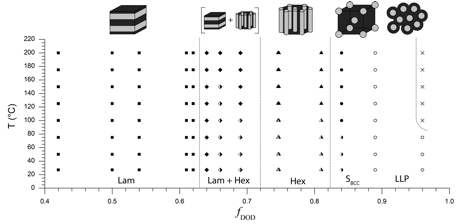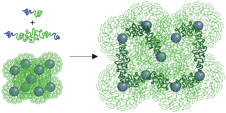58th Annual Report on Research 2013 Under Sponsorship of the ACS Petroleum Research Fund
Reports: ND752018-ND7: Block Copolymer Based Poly(RTIL)-RTIL Composite Membranes for CO2 Separation and Sequestration
Travis S. Bailey, PhD, Colorado State University
The project as defined by the proposal was concerned with the synthetic development of new polymeric materials and membrane structures aimed at the efficient separation of CO2 from flue and other light gas mixtures. Our current dependence on fossil fuel-based power plants translates to billions of tons of CO2 emitted into the atmosphere each year which suggests significant clean energy research expenditures must remain focused on CO2 capture and removal technologies. Room temperature ionic liquids (RTILs) have emerged as promising candidates in this regard, with combinations of CO2 permeability and CO2/N2 selectivity that consistently concentrate near, and often surpass, the historical upper bound for polymeric membranes.1 However, industrially practical membrane configurations have yet to be realized,2-5 due to an inability to translate the exceptional permeabilities and selectivities of liquid systems into robust membrane configurations suitable for industrial-scale processing of large gas volumes. Ultimately, the challenge lies in the formation of mechanically robust thin films (1-10 mm) that retain liquid-like transport behavior. Overcoming this obstacle was the motivating objective of the work supported by this grant.
Towards this end, the research activities have been focused on the synthesis of structured block copolymer-based poly(RTIL)-RTIL composite membranes based on a tethered-micelle network paradigm.6 In the first year, most of the work was concentrated on the synthesis of poly(RTIL) block copolymer target molecules, and characterizing their thermodynamic phase behavior. The results of these initial studies performed in collaboration with the Gin and Noble groups from CU Boulder have resulted in two publications. [REF] The focus of the first publication was simply to establish the baseline phase behavior and morphological characteristics associated with the non-photocurable analogs of the block copolymer target molecules proposed in the originally proposed research plan. The model target molecules first investigated are shown below.
In total, 16 diblock copolymers were synthesized and characterized leading to the following phase diagram for this set of model molecules of varying block compositions.
The key results from this phase diagram was the clear appearance of the spherical phase necessary for eventual formation of the proposed tethered micelle networks serving as the membrane framework for CO2 separations. Prior to this work, there existed little to no concrete evidence that polyRTIL containing block copolymers, with inherently large values of the Flory interaction parameter, would be able to establish the necessary spherical morphology.
Importantly, the ACS PRF funding allowed our group to begin investigating these novel systems and work with two of the leading experts in RTIL use for light gas separations. The collaboration permitted Vincent Scalfani, in his last year of his Ph.D work, to integrate collaboratively with students and post-docs from the Gin and Noble groups at CU Boulder prior to his successful defense. He now is an Assistant Professor at the University of Alabama, and notably continues to collaborate with fellow University of Alabama faculty member Jason Bara, who was a member of both the Gin and Noble groups. These very successful relationships developed solely as a result of the ACS New Directions Grant Proposal Program.
With these results in hand, the project has changed focus now towards the integration of photocurable blocks necessary for ultimate formation of the tethered micelle membrane assemblies proposed. This tethered micelle network is based on the combination of AB diblock and ABA triblock copolymers as shown in the pictorial representation below.
A new student, Dilanji Wijayasekara is now driving this phase of the project, exploring two synthetic routes aimed at creating such an AB diblock and ABA triblock copolymer combinations in which the A block is photocurable and the B block is a polyRTIL.
The primary route explored over the last year is that which was originally proposed, in which the AB diblock and ABA triblock copolymers are based on ROMP of norbornene based monomer derivatives .
Concurrent with this approach, DW is also pursuing a new synthetic route to a divergent set of AB diblock and ABA triblock copolymers in which the photocurable A block is based on a polydiene derivative, while the polyRTIL block is based on a polyether derivative. This new system is based on several advantages associated with the efficiency of cationic ring opening polymerization of epoxides as a curing chemistry combined with the added efficiency of polyether derivatives in CO2 separation selectivities.
In the next year, we anticipate the project advancing past the synthetic stage and progressing into the membrane fabrication and measurement stages. DW will continue to be supported on this ACS New Directions Grant until its completion.
References
1. Camper, D.; Bara, J.; Koval, C.; Noble, R., "Bulk-Fluid Solubility and Membrane Feasibility of Rmim-Based Room-Temperature Ionic Liquids", Industrial & Engineering Chemistry Research 2006, 45 (18), 6279-6283.
2. Bara, J. E.; Camper, D. E.; Gin, D. L.; Noble, R. D., "Room-Temperature Ionic Liquids and Composite Materials: Platform Technologies for CO2 Capture", Accounts of Chemical Research 2009, 43 (1), 152-159.
3. Bara, J. E.; Carlisle, T. K.; Gabriel, C. J.; Camper, D.; Finotello, A.; Gin, D. L.; Noble, R. D., "Guide to CO2 Separations in Imidazolium-Based Room-Temperature Ionic Liquids", Industrial & Engineering Chemistry Research 2009, 48 (6), 2739-2751.
4. Hasib-ur-Rahman, M.; Saij, M.; Larachi, F., "Ionic Liquids for CO2 Capture - Development and Progress", Chemical Engineering and Processing 2010, 49, 313-322.
5. Jones, C. W., "CO2 Capture from Dilute Gases as a Component of Moder Global Carbon Management", Annu. Rev. Chem. Biomol. Eng. 2011, 2, 2.1-2.22.
6. Guo, C.; Bailey, T. S., "Highly Distensible Nanostructured Elastic Hydrogels from AB Diblock and ABA Triblock Copolymer Melt Blends", Soft Matter 2010, 6, 4807-4818.
Copyright © 2014 American Chemical Society















